































and Richard.

It’s summertime and from the looks of all the submitted photos we received for this issue of the magazine there have been a lot of folks snapping it like it was hot. I just want to personally thank all those who submitted photos for the magazine. We got some really great pictures. I mean, every time a photo came in, I would get a smile on my face. And, of course, I couldn’t help myself: I found a vintage photo of a great summer shot when my family traveled to Hawaii in 1970 to visit my Aunt Glo and Uncle Jim.
Don’t you just love summer? I loved all the feedback we got for this issue of the magazine.
Our goal for Vicksburg Living is to connect with the community, share the stories of our people and past, and to have a good time doing it. And thanks to all of you that mission was accomplished.
In addition to all these awesome photos,
in this issue of the magazine my friend Martha Whitaker wrote an amazing story on Anthony Virgadamo and the award that was named in his honor and is given out each year to a deserving St. Aloysius football player. Martha has done extensive research through the Korean War project and brought great depth and insight into a local man who gave his life in service.
For our house feature, Patrick and Kristi Smith opened the doors of their home, which showcases elements of life on the Mississippi River. We also have a story about Vicksburg’s first Chinese restaurant, Al and Cindy Windham’s party-ready home, tasty summer sipping recipes and ideas on hosting a themed birthday party.
Enjoy,


Administration
Catherine Boone Hadaway
Blake Bell
Vicksburg Living Editor
Terri Cowart Frazier
Marketing
Justin Clarkston
Mallory Hoffman
Jillian Norris
Contributors
Ernest Bowker
Sally Phillips
Ben Martin
Audience & Accounting Services
Shandale Goodman
Contact Information
Vicksburg Living 1106 Washington Street Vicksburg, MS 39183 601-636-4545
Vicksburg Living is published six times each year by Vicksburg Newsmedia, LLC, 1106 Washington Street, Vicksburg, MS 39183. Vicksburg Living is a registered trademark. All contents herein are the sole property of Vicksburg Newsmedia, LLC [the Publisher]. No part of this periodical may be reproduced without written permission from the Publisher.
Please address all correspondence (including but not limited to letters, story ideas and requests for reprint materials) to Editor, Vicksburg Living, 1106 Washington Street, Vicksburg, MS 39183.
Vicksburg Living is offered by subscription, and a limited number of free copies are available at local locations. For information on receiving Vicksburg Living at your home, call (601) 636-4545.
Advertising inquiries may be made by emailing advertising@vicksburgpost.com or by calling (601) 636-4545.
Proudly Produced in Vicksburg, Mississippi.

Copyright 2025 by Vicksburg













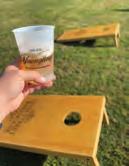



















Ideas on how to throw a themed party







INGREDIENTS
1 quart pineapple juice
13.5 ounce can coconut milk
½ cup powdered sugar Pineapple for garnish Rum (I use Bacardi Silver Light Rum)
INSTRUCTIONS
Can be served over ice or blended. In a pitcher, mix juice, milk and sugar. Whisk together until sugar is dissolved. For frozen, add ice and mixture to blender and blend until smooth. For rocks, serve over ice. Add a shot of rum to each glass for a cocktail and garnish with pineapple.


1 quart lemonade (I use Simply
½ pound fresh strawberries, stemmed, plus a few for garnish
peach juice. Chill for an hour so basil has time to flavor juice. Serve in an iced wine glass. Add prosecco to add some bubbles. Garnish with basil and a peach slice.
INGREDIENTS
1 pint fresh or frozen blueberries
1 cup sugar
In a small food processor, blend strawberries and sugar. In a tall, iced glass, add 2-3 tablespoons of strawberry puree then top with lemonade. Add a shot of vodka to each glass to make a cocktail.
1 cup water
20 fresh mint leaves
Brewed tea, can use store bought (I use Milo’s Splenda Tea) Bourbon (I use Maker’s Mark or Jack Daniels)
1 quart peach juice (I use Simply
10 leaves basil, plus more for
Finely chop basil and add to
In a saucepan, combine berries, sugar, water and mint leaves. Simmer for 10 minutes. Let cool.
Blend in a food processor or with an immersion blender. Add 2-3 tablespoons of blueberry mint syrup to tall, iced glasses. Fill with tea and garnish with mint leaves. Add a shot of bourbon for a refreshing cocktail.


“MARK
CHERNOW
Before he was Mark Twain, he was Samuel Langhorne Clemens, born almost 200 years ago to become America’s first literary celebrity. In this rich portrait of Twain, Pulitzer Prize-winning biographer Ron Chernow reveals a journalist turned novelist who sought fame and fortune while carefully crafting his persona. We associate Twain with his classics like “The Adventures of Tom Sawyer and Adventures of Huckleberry Finn,” but Chernow presents a life far more complex than that of a simple author.

The seventh in the Penn Cage series, Greg Iles unveils the writing style and historic depth that made the “Natchez Burning” trilogy a searing masterpiece. His character, Penn Cage, finds himself in an America teetering on anarchy and a Mississippi region driven toward a race war. Readers see him called again into action by deadly attacks, burning plantation homes, and a political ascension that threatens the very roots of American democracy.
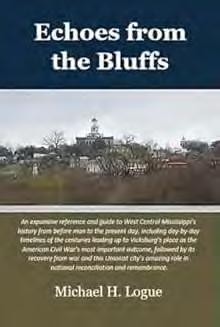
“ECHOES OF THE BLUFFS” BY
MICHAEL LOGUE
A valuable contribution to Vicksburg’s bicentennial commemoration, this updated edition offers an expansive history of Vicksburg and Warren County. Extensive timelines from the very creation of the Mississippi River to the present day include more than 6,000 vignettes and facts. Winner of a Mississippi Historical Society award of merit, this reference collection captures all a reader wants to know about Vicksburg’s place in American history as the city lays its path to the future.

“MISSISSIPPI CURRENT COOKBOOK: A CULINARY JOURNEY DOWN AMERICA’S GREATEST RIVER” BY REGINA CHARBONEAU
This diverse food and culinary guide traces traditions from the 10 states that border America’s most important river with 200 contemporary recipes and more than 150 stunning photographs. Author Regina Charboneau has launched top restaurants in Natchez and San Francisco. A culinary director of the American Queen paddle wheeler, she also founded a cooking school specializing in Southern cooking classes, Regina’s Kitchen. Now, she takes readers on a delicious journey through the dishes and ingredients of those who make their home along the Mississippi.

“HIDDEN HISTORY OF VICKSBURG” BY
RYAN STARRETT AND JOSH FOREMAN
Discover all-but-forgotten elements of Vicksburg history in this book that explores the land and the people who make Vicksburg one of the South’s most visited and recognizable cities. The generation of the city’s official founding 200 years ago witnessed vigilantes and duelists roaming its streets. Over the decades, citizens experienced war, maritime supremacy and disaster, and retail successes that embody the American dream.













Birthday celebrations are fun no matter what your age and Mary Kaylin Gray, the owner of MK Designs, shares a few tips on how to make every event special.
“When throwing a birthday party, you first need to think about the overall feel of the party — do you want something small, cute, and low-street, or a larger, more elaborate celebration?” she said. “Second, think about whether you’d like to have a specific theme.”

MARY KAYLIN GRAY
When it comes to deciding on a theme for a birthday party, Gray said, “For kids and teens, think about centering the theme around a favorite book, toy, or movie. And for adults, you can draw inspiration from a hobby, interest, or even a fun throwback decade.”
Once a theme is chosen, Gray said you can emphasize it by incorporating decorations, themed food, drinks, and matching paper goods like plates, napkins and invitations.
And for those who are wondering if the birthday cake must be an exact replica of the party theme, Gray said there are many ways it can be used to compliment the party theme.
“A cake doesn’t have to match the theme exactly,” Gray said. “Instead, you can coordinate by prioritizing flavor, add simple touches like flowers, or by pairing a cake with cookies and other sweets, which can be just as beautiful and memorable.”









Wing Suey Tom came to the United States from China in 1931 when he was 18 years old and after finishing his education. He worked at a grocery store his father opened on Mulberry Street in the early 1940’s. Soon after opening, his father began getting requests for him to cook. It was then that he decided to open a cafe at the store.
In a Vicksburg Post article from 1978, Tom recalled that the cafe “was probably the only place where you could get red beans and rice for 10 cents. Hamburgers were five cents each and hot dogs were two for a nickel. We did good business.”
Soon, Tom’s father added Chinese dishes to the menu. It was, by all accounts, the only place in Vicksburg where people could get them.
Tom was married in China in 1931, but his wife only made it to Vicksburg in 1950.
In 1953, a tornado devastated Vicksburg and destroyed the grocery store on Mulberry Street. The following year, the Toms built a new grocery store at 1102 Washington St.
In 1966, Tom began Tom’s Kitchen, where patrons could get takeout Chinese food that was prepared in a kitchen in the back of the grocery store.
One of Tom’s sons, Joe Tom, spoke to The Post about growing up in the family business. He and his family lived in an apartment above the grocery store.
“It seems like a majority of the Chinese families that I know of throughout Mississippi, when they had a business, they lived either above or behind that business,” Joe said. “It was always part of the household to have a business connected to it.”


“The Chinese train of thought for many years is that we’re going to open up a business and we’re going to run it to make a living, not to make money and become rich. (Tom) didn’t become a millionaire running a restaurant. And it’s long, long hours and a lot of preparation work, you know, cutting up meat, cutting up vegetables, preparing everything for the lunch crowd and then for the dinner crowd. It was a lot of work.”
— Joe Tom




In the 1978 article, Tom was quoted as saying, “I know a few things (about cooking), that’s all.” He also mentioned that his culinary knowledge came from cookbooks and the occasional Chinese newspaper.
“Cooking so much (for a restaurant) is no problem, you just need a little time to prepare,” he said.
Joe said his favorite dish served at the restaurants was the shrimp Cantonese.
“It’s stir-fried shrimp with what’s called a lobster sauce in it, has a little bit of ground up pork, some onions in it, and a white gravy, white sauce, and you serve that over rice,” he said. “Not a lot of Chinese restaurants serve that. But that must have been something my dad must have thought of.”
Steven Marcus of Marcus Furniture remembers being a big fan of the restaurant.
“It was wonderful, it really was. Best rice in town, egg rolls, barbecue pork,” Marcus said. “It was really good. Really good.”

Marcus even remembered some of the advertising for the store.
“They had a famous sign that read ‘You can’t beat Tom’s meat,’” he said.
Joe remembered him and his three sib-
lings helping out at the establishment.
“The Chinese train of thought for many years is that we’re going to open up a business and we’re going to run it to make a living, not to make money and become rich,”



Joe said. “(Tom) didn’t become a millionaire running a restaurant. And it’s long, long hours and a lot of preparation work, you know, cutting up meat, cutting up vegetables, preparing everything for the lunch crowd and then for the dinner crowd. It was a lot of work.”
Tom retired in 1976, but a few years later, he helped his daughter Lillian open another Tom’s Kitchen location at 1805 Clay St.
In an article from The Vicksburg Post from March 1987, Lillian remembered her time at the Washington Street location.
“I grew up in the grocery business,” she said. “We got to do things a lot of kids didn’t get to do.”
Lillian began working at her father’s store when she was around 7 or 8 years old, collecting money from customers. Lillian’s two brothers, George and Joe, helped run the new establishment.
“Everyone had their own job to do,” she added.
The restaurant was still mainly takeout, but added some limited seating that the original Tom’s Kitchen lacked. In 1987, the lunch special cost $3.16. At that time, Lillian said they were serving about 75 lunch customers per day.
In the article, Lillian said that when she was growing up, Vicksburg had a sizeable community of Chinese immigrants and descendants of immigrants. However, she said, by 1987, many of the young people from that community had moved away.
Tom’s Kitchen has since closed. Today, there are multiple places in town where one can get delicious Chinese cuisine, but the Toms have the distinction of being the first to offer it.







Showers might have hampered guests from enjoying Al and Cindy Windham’s backyard during the engagement party held for Vicksburg native Granville Engle and his fiancé, Mila Buckner, a New York resident. But as breathtaking as the garden was, the festive party scheme inside the Windham’s home was just as stunning. From the whimsical dining room table décor to the garden rooms’ floral arrangements, all gave a nod to Granville and Mila’s upcoming nuptials.
Al and Cindy are no strangers to entertaining. The couple has hosted many parties, even a wedding reception for their youngest daughter, Sarah Louise. Attendees are always regaled by the Georgian style home’s interior, as well as the backyard.
Cindy said Al comes from a family of “avid” gardeners.



“His mother always gardened. She grew award-winning iris,” she said. “And his sister, Kay Turner, is also a gardener, which means any time she and Al get together, conversation always includes a discussion of gardens and plants.”
For those who have had the pleasure of visiting Al’s garden, those familial talents are evident. The couple’s backyard is nothing less than enchanting — as if fairies and nymphs are frolicking in and amongst all the beauty. There is a babbling brook that flows down the hill of the property, stately busts, concrete benches, woodland animals, and garden pathways that wind through arches of greenery.


Cindy said Al started creating the backyard garden about 25 years ago, adding and incorporating over time ideas they gathered during their travels.
“We love to visit gardens when we travel,” Cindy said. While touring them, she said, Al observed the importance of focal point and hardscapes.
“He has added hardscapes by building paths, decks and arbors. And he adds statuary to create focal points,” she said. For the engagement celebration, several of these statuaries were festooned with bridal veils.
With a “naturally occurring depression in the yard,” Cindy said a stream was also constructed. She said landscape architect Mac Ferris was called in to help with this project.




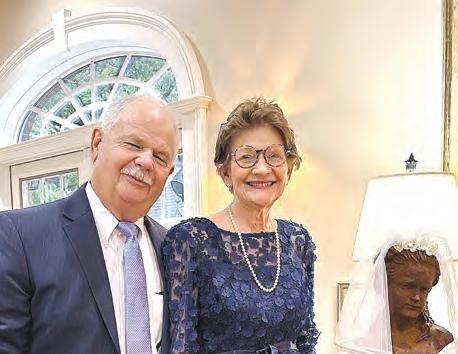



As for plant material, Cindy said because their yard is bathed in shade, most of the plants Al has used include azaleas, hydrangeas, ferns and a variety of hostas.
To maintain this ethereal paradise, Cindy said Al usually spends at least some part of every day working in the garden.
Although it was raining outside, and a tour through the garden was impossible, the engagement party celebrating Granville
and Mia was no less picturesque inside the Windhams’ home, starting with the outside entrance.
Small obelisk-like garden trellises were placed within massive ferns outside the door. One donned a bridal veil and bouquet, and the other a top hat and bow tie. A basket of fresh flowers and ivy hung from the door.
Cindy continued the wedding theme inside the home by incorporating it into the floral arrangements.
In the garden room, male and female
head planters were used as the centerpieces. The female head was filled with a variety of white flowers. A veil was also added. The male head was decorated with greenery and a bow tie.
Perhaps the pièce de résistance, however, was the floral arrangements for the dining room table. Three mannequin heads were used, adding a bit of whimsy to the formal setting.
“We first saw mannequin heads used as flower containers at the Philadelphia,

Pennsylvania flower show,” Cindy said, adding that Geni Fulcher of the Ivy Place made the arrangements that were placed on the foam heads — two denoting bridesmaids and one the bride.
Catering the engagement affair was Helen Abraham catering.
Granville is the son of Melanie Bowman, who just happens to live next door to the Windhams.
“Melanie has been a dear friend and neighbor for many years,” Cindy said. “Our children are the same age and knew each other growing up. We were delighted to host the engagement party of her son and his fiancée.”
“We first saw mannequin heads used as flower containers at the Philadelphia, Pennsylvania flower show,” Cindy said, adding that Geni Fulcher of the Ivy Place made the arrangements that were placed on the foam heads — two denoting bridesmaids and one the bride.


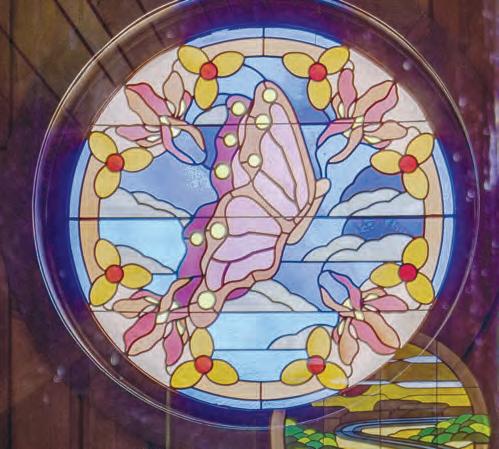


During the 1940s, Elmer and Volga “Bob” Platte began buying parcels of land along Freetown Road. The couple wanted to raise cattle, which they did until Elmer’s untimely death in the 1960s. While the land is no longer used for livestock, descendants of the couple still live on the property — including their great-grandson Patrick Smith, his wife Kristi, and their three children, Jack, Vaylor and Hart.
Patrick and Kristi met in 2005 at a New Year’s Eve party in Merigold, Mississippi. Patrick, a talented musician, had been asked to perform at the event.
Kristi said that although they didn’t “really” start dating until a few months after the party, “the connection was instantaneous.”
Later, the couple learned that the late “Big J.O.” Smith — Patrick’s father — and Kristi’s uncle had been longtime business associates and friends.
“Which is how my cousin knew him (Patrick) and asked him to play for New Year’s Eve,” Kristi said.
For nearly a century, Patrick’s extended family has lived on the land where Elmer and Volga once set down roots.
“The original homestead on this property — which Elmer and Volga Platte lived in — was a traditional white siding farmhouse that sat in the front yard of where the current house is located,” Kristi said. “And the driveway of the current house is where Elmer Platte died of a wasp sting to the eye in 1960.”
After Elmer’s death, Volga inherited the property. When she died in 1987, she divided it among the couple’s four granddaughters: Patricia (“Petesy”), Jo, Bobbie and Logan.
Petesy and Big J.O. — her husband at the time — moved into the original farmhouse and continued raising cattle with their four children, Lela, twins Jinx and J.O., and Patrick.
“During this era, Petesy was involved in the cattle operation, and Big J.O. took over Elmer’s boat business,” Kristi said. That business had been started by J.W. Platte







“While working on the river, J.O. found several old cypress logs — remnants of log rafts from the turn of the century when the Mississippi Delta was being cleared for farmland. He salvaged them and bartered with AndersonTully to have the wood planed and milled into what now adorns our home.”
— Kristi Smith


of Burlington, Iowa, and his son Elmer — Petesy’s great-grandfather and grandfather, respectively.
“In addition to the cattle operation, it was during this time that the Smith family became more involved with the Warren County 4-H program, mentoring many of the youth in the area,” she added.
Life changed dramatically in 1972 when the original farmhouse burned down.
“While playing with matches in their father’s closet, the twins (J.O. and Jinx) burned the original house to the ground,” Kristi said. “So, needing a place to live, Big J.O. and Petesy purchased a used double-wide trailer for their family.”
The trailer was placed on the property near the original home site. The family
lived there for nearly 14 years while Big J.O. and Petesy — with help from Big J.O.’s brother, Ephraim Smith, a structural engineer — designed and built the house that now belongs to Patrick and Kristi.
To say the Smith home is unique is an understatement. From tongue-and-groove cypress to stained-glass windows, the home reflects the river in both structure and spirit.
During his life, J.O. built what Kristi described as “river-based businesses,” including Big River Shipbuilders.
“With his knowledge from the shipbuilding and fabrication business, J.O. and his employees built the bones of this house
out of steel,” Kristi said. “Then, he hired Al Gullett and his family to cover those bones with beautiful tongue-and-groove cypress.”
That cypress came with its own story.
“While working on the river, J.O. found several old cypress logs — remnants of log rafts from the turn of the century when the Mississippi Delta was being cleared for farmland,” she said. “He salvaged them and bartered with Anderson-Tully to have the wood planed and milled into what now adorns our home.”
What makes the cypress even more meaningful is Kristi’s connection to it.
“At the turn of the century, a couple named Mary and Frank Hamilton managed lumber camps in the Mississippi Delta. They were my great-great-grandparents,”



she said. “I like to believe it was providential that they sent those logs down the river so that, 100 years later, J.O. Smith could find them, salvage them, and build the house that I now raise my family in.”
The home also features two stained-glass windows. One, chosen by Petesy, is a butterfly design, and the other by J.O. depicts a river and towboat.
“The house is positioned exactly north, south, east and west, with the stained-glass windows on the east and west walls. When the sun rises and sets, the colors fill the living room beautifully,” Kristi said.
In August 2006, Big J.O. died of a heart attack in the house. Patrick and Kristi moved in two years later.
“In late 2008, we moved into the house after it sat empty for nearly three years,” Kristi said. In 2017, they purchased the home from Patrick’s father’s estate and began renovations in 2021.



“Structurally, the house remains the same,” Kristi said, though the floor plan has been significantly updated with added steel, larger windows and doors, new handrails, and modern appliances.
“Our favorite appliance is the plumbed coffee maker,” she said.
The couple used the original roof line to enclose part of the porch and add a breakfast room, master suite, office, mudroom, and his-and-her closets. They also finished out previously unused space, including a concrete safe room.
The house’s original geothermal heating and cooling system was replaced with a new HVAC system.
Kristi said her favorite space is the kitchen and keeping room.
“Whether we are cooking, eating, doing homework, visiting, practicing instruments, or having an impromptu jam session, this is our space. We do a lot of living here.”
The keeping room also serves as the family’s music room. Patrick’s musical talents are now shared with their children. Jack plays trombone and drums; Vaylor plays saxophone and piano; Hart sings and plays trumpet.
A Steinway & Sons piano — a family heirloom once played by Patrick’s father — now lives in the keeping room.
“Our children have learned to play on it. It’s part of many special occasions when we gather,” Kristi said.
Kristi describes their home’s style as “eclectic,” influenced by their roots, music, nature and the river.
“Almost all of the art is local or regional, including works by Lucius Lamar, H.C. Porter,






Caroline Gatling, Bob Pickett, Claiborne Cooksey, Jim Seale — and, of course, our favorite artists, our children.”
One meaningful piece in the collection is a triptych titled “Fire, Earth and Water” and painted by Lucius Lamar. It was inspired by “Trails of the Earth,” memoirs by Mary Mann Hamilton — Kristi’s great-great-grandmother — who documented life clearing the Mississippi Delta.
“I think it’s symbolic and, again, somehow providential, that this piece of art hangs in our home,” she said.
Shortly after making renovations to the house, Patrick and Kristi added a pool and outdoor living space.
“We started construction shortly after finishing the house remodel. It’s been a wonderful addition, especially with the children at the ages they are now,” Kristi said. “We spend a lot of time here with friends and family. It’s definitely one of our favorite places to be.”
“It’s been a joy to not only live on this beautiful property but to watch my children grow up here knowing they’re enjoying the same land, creeks, lakes and fields that generations of their family have loved and protected,” Kristi said.
The land, she said, has served not only as home, but also as a gathering place for weddings, receptions, baby showers, civic events, family reunions and the family’s traditional annual Easter celebration.
But perhaps most importantly, it has served as a sanctuary.
“One of the most special aspects of our home is that it’s geared toward relaxing and decompressing,” Kristi said.


PHOTOS SUBMITTED
This fall season of St. Aloysius football will mark 75 years of honoring one standout player who was killed in Korea during “The Forgotten War.” Anthony Paul Virgadamo, however, has never been forgotten in Vicksburg. Every year a senior Flashes football player who has lived his life in much the same way as Tony did joins the proud ranks of Virgadamo Award recipients. Tony’s athletic ability, scholarship and character not only allowed him to live life to the fullest, but set forth a formula for the award that is named in his honor.
“There are many significant awards across the country in countless schools, but it would be difficult to find one that has the history and the emotion of the Virgadamo Award,” St. Aloysius principal Dawn Meeks said. “For 75 years at St. Aloysius High School, this award has symbolized not only excellence in academics, athletics, and moral character, but represents the very essence of what we strive to achieve with every student who walks through our halls. Anthony Virgadamo exemplified these virtues, and the award established in his honor has been and will continue to be one of the most illustrious and coveted awards in our school’s long history. The original trophy with the names of each winner since 1950 sits in a place of honor in our foyer as a reminder of what it means to be the best you can be in service to others.”
The foundation of the award is, of course, football. In 1947, Tony’s senior

1950 Robert Baylot
1951 Clint Schlottman
1952 William Carrigan
1953 Joe Durst
1954 John Banchetti
1955 William Gargaro
1956 Edward Lucchesi and Karl Nicholas
1957 Paul Hosemann and Mike Morrisey
1959 Bobby Gordon and Jim “Monk” Monsour
1960 John Downey
1961 David Nohra
1962 Greg Doiron
1963 Roy Woody
1964 Joe Maggio
1965 Tom Balzli
1966 Billy McCain
1958 George Evans and Eddie Habert
1967 Bernie Callaway
1968 Frank Koe
1969 Carl Franco
1970 Bobby Baylot
1971 Larry Rocconi
1972 David Hosemann
1973 Bill Loyacano
1974 Murray Whitaker
1975 Dennis Southard
1976 Murray Pinkston
1977 Donnie Head
1978 Joe Battalio
1979 Lanny Barfield
1980 George McConnell
1981 Cicero LaHatte and Barry Breithaupt
1982 Pat Evans
1983 Joe Evans
1984 Corey Pinkston
1985 Mark Simrall
1986 John Agostinelli and Jeff Jones
1987 Kette Dornbusch

year, football equipment was different but the heart of the game was the same. Back then even the appropriate pregame hype was supplied by sports writers from The Vicksburg Post who said the St. Aloysius team captain possessed “blazing speed” and was “one of the scrappier men on this team of scrappers.”
The team’s hopes were pinned on Virgadamo, and he didn’t disappoint. In one game that year he not only executed his signature break-and-run play, he added some flair. He broke from the pack, made a clean run, scored the winning touchdown, heard the buzzer sound for game over but
circled back anyway, kept running, and ran straight up the student section to hold that winning ball over his head for all the kids to admire.
St. Al finished with an 8-1 record that season, with the only blemish on its record a 7-6 loss to Crystal Springs in October.
Anthony Paul Virgadamo was small, but he was highly motivated by the athletic challenge and his fellow teammates — some of the same things that motivate young athletes today. His friend, the late Jack Stamm, once said, “It was Tony who did a lot of the motivating for the team. If we needed a pep talk at halftime, he gave it
all he had.”
Tony seemed equally determined to perform in the classroom. He must have been a good student all along but in high school he was even more motivated. Prior to his freshman year, high school students knew the only ones who would be lucky enough to go to college were the children of wealthy parents. But in 1944, the G.I. bill was passed and gave young men like Tony substantial hope for any career they dreamed of if they served in the military.
Tony’s academic life was summed up by his friend Donnie Tuminello. All indications are that Tony maintained a respect-
2020
2021
2022
2023
2024

able balance of effort on and off the field.
“Tony was not a straight-A student but there were straight-A students who could not play football the way Tony could,” Tuminello said.
There is a third consideration for the Virgadamo Award woven into both athleticism and scholarship. It is often referred to as character or leadership. Tony and a couple of his friends were once lectured by Brother Ignatius that they were born leaders but were leading guys in the wrong direction. That seems to be exactly what made Tony so likeable. He was not always perfect but almost always had a smile on his face and put his whole heart into what he did. Those were the reasons he was voted Class Favorite more than once, as well as the captain of the football team, and years later recalled as the best friend of so many.
Like many of his friends, Tony decided to take the military up on its offer and he chose the Marines. It probably wasn’t a coincidence that his much-admired football coach, Joe Balzli, had served in the Marines a few years earlier during World War II. Shortly after graduation, Tony reported to basic training and eventually rose to the rank of corporal.
In June of 1950, just two years after Tony graduated from high school, there was a Marine Corps call to volunteer in Korea. Tuminello remarked that Tony, of course, volunteered.
“That’s just how he was. He liked to be the leader of the pack,” Tuminello said.
The fighting in Korea continued longer than anyone expected. By October, sons and mothers had exchanged a few letters. As a result of this unofficial intelligence, three former Flashes teammates — Tony, Murray Pinkston, and Charlie Foley — met up 7,000 miles from home. No one knows what they talked about, but everyone can imagine.
The 3rd Battalion, 5th Marine Regiment, 1st Marine Division, of which Tony was a member, left base camp at the end of October and headed north. They went as far as the Chosin Basin where they were ultimately surrounded by the Chinese army in late November. Their commanding officer Col. Chesty Puller was ordered to withdraw but he clearly disliked the word


and responded, “Retreat hell, we’re fighting. In the opposite direction.”
This time even Tony had no scrappy plays. The Battle of the Chosin Reservoir lasted for 17 days and became the most infamously brutal fight in the entire Korean War, as United Nations forces comprised of American, British and Korean troops tried to evacuate down a single 78-mile road through the mountainous North Korean terrain to the port city of Hungnam.
It was a grueling trek through 20- to 30-degree below-zero temperatures, an endless supply of snipers, and a diet of frozen pineapple juice and Tootsie Rolls while outnumbered 4-to-1. Some of the guys made it back. Many did not. A third of the 30,000 U.N. troops who fought in the battle were killed, wounded, or listed as missing in action. Another 7,300 suffered non-battle injuries such as frostbite from the bitterly cold

weather. Those who fought in the battle earned the nickname “The Chosin Few.”
Pinkston was said to have asked as many returning soldiers as he could if they knew where Virgadamo was. He finally got the answer he did not want.
On Dec. 2, Tony was killed in action as his unit attempted to keep the Communist Chinese Forces

The team’s hopes were pinned on Virgadamo, and he didn’t disappoint. In one game that year he not only executed his signature breakand-run play, he added some flair. He broke from the pack, made a clean run, scored the winning touchdown, heard the buzzer sound for game over but circled back anyway, kept running, and ran straight up the student section to hold that winning ball over his head for all the kids to admire.







from gaining control of a hill that overlooked the evacuation route. He was buried alongside the road. Today, Tony’s name is memorialized on the Courts of the Missing at the National Memorial Cemetery of the Pacific. His name is also inscribed on the Korean War Veterans Memorial Wall in Washington, D.C.
Tony’s family was living in Gulfport when they were notified of his death, so Mrs. Virgadamo called her friend, Donnie’s mother Mary Tuminello, in Vicksburg. On Mrs. Tuminello’s word, The Vicksburg Post printed the news on the front page on Dec. 14, 1950.
A month later, a proposal was made at St. Aloysius to establish a football award named in Tony’s honor. A previous award
honoring the school’s top athlete was being phased out and this one would replace it. It was sponsored by Tony’s classmates from the graduating Class of 1948.
“When the members of the graduating Class of 1948 heard that the student athlete trophy was finished they came up with a magnificent suggestion, a trophy to perpetuate the memory of their classmate, Anthony Virgadamo, a recent casualty of the Korean war,” Brother Mark, the St. Aloysius principal at the time, told The Post.
The first recipient was Robert Baylot in January 1951. And, every year since, the Virgadamo Award has been the most coveted of the St. Aloysius athletic awards.
The 2025 Virgadamo recipient will soon take his place in the long line of honorees.
Like the others, he will share many of the qualities Tony exhibited. He also gives something back to Tony — a legacy. Each in his own way represents all that Tony could have been. They are husbands and fathers, long-distance runners and carpool drivers, lawyers, engineers, and doctors. They are pro football players and backyard pitchers. They are restaurateurs and volunteers. They are the men who have never forgotten Anthony Paul Virgadamo.
John Murray Pinkston is an attorney in Chicago and the 1976 recipient of the Virgadamo award. His father is Murray Pinkston, who attended school with Virgadamo and served with him in Korea. The younger Pinkston said the award is much bigger than a simple sports trophy.

“The Virgadamo Award is not nearly so much about honoring the yearly recipient as it is about honoring Tony Virgadamo himself,” John Murray Pinkston said. “Tony is a real hero, an incredibly brave soldier who sacrificed his own life to save the lives of the other soldiers in his
platoon. I am very proud to have received the Virgadamo Award and thus to have been a small part of this tradition, 75 years in a row now, in which the St. Aloysius family gathers to recognize a good year for an athlete by reminding ourselves and teaching others of what actual heroism really is.”











Vicksburg readers share summertime funtime pics



























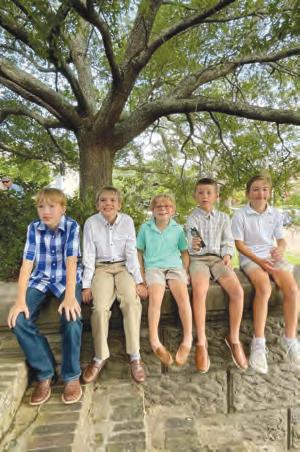





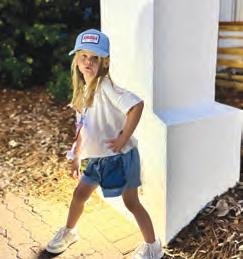












Shelby and Blake Purvis with children Leighton and Elliot









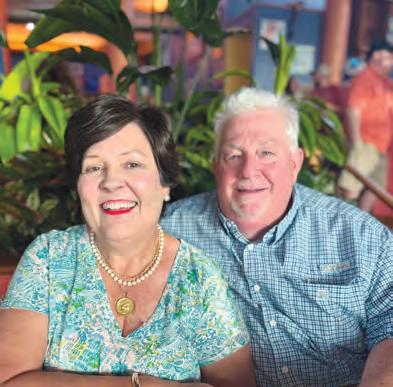










“
“You never know the value of a moment until it becomes a memory.”
— Dr. Seuss


















































